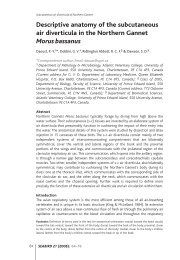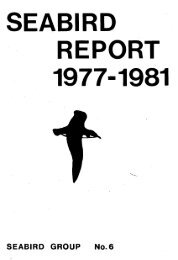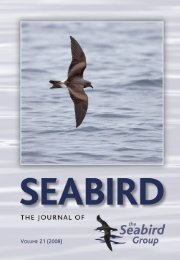You also want an ePaper? Increase the reach of your titles
YUMPU automatically turns print PDFs into web optimized ePapers that Google loves.
2001 <strong>Seabird</strong>s on Ascension 195<br />
06°33'N 18°06'W in July 1838, with "Rhynchops" (presumably Sooty Terns?)<br />
and frigates (Gould 1840). <strong>The</strong>re is another old F. t. tropica from 00°12°S<br />
30°W, a Tristan White-bellied Storm-petrel F. grallaria leucogaster from<br />
07°05'S 03°30'W on 11 Apr 1950, and a Tristan White-faced Storm-petrel<br />
Pelagodroma m. marina from 05°S 4°W on 23 Apr 1957, all in moult, and an<br />
Antarctic Tern Sterna vittata said to come from between Ascension and St.<br />
Helena (Saunders 1876) in the (British) Natural History Museum, and two F. g.<br />
leucogaster from 03°02'S 03°W on 31 May 1916 at Leiden.<br />
POTENTIAL ENSO-RELATED EVENTS<br />
St Helena was included among the areas affected by droughts during a major El<br />
Niño-Southern Oscillation or ENSO due to global fluctuations in the<br />
atmospheric pressure as early as 1791 (Grove 1998). Similar events have been<br />
identified again in the Atlantic as well as the Pacific during more recent major<br />
ENSOs (symposium in �ature 322: 236-253; Longhurst & Pauly 1987; Glantz<br />
1996; Davis 2001). <strong>The</strong>se include a long series of records of fluctuations in the<br />
Humboldt Current affecting breeding seabirds at the time of the arrival of El<br />
Niño at Christmas along the west coast of South America, and more recently the<br />
Benguela Current off SW Africa and the Christmas Island which occupies a<br />
comparable position to Ascension on the north side of the equatorial current<br />
system in the central Pacific (Duffy & Schreiber1988; Schreiber & Schreiber<br />
1989). While there are few regular records of tropical seabird breeding<br />
performance on oceanic islands elsewhere except recently for Roseate Terns<br />
showing a similar pattern in the Seychelles in the Indian Ocean (Ramos 1998),<br />
on Ascension there are also records of exceptional rainfall (Duffey 1964;<br />
Walmsley 1997), also be related to ENSOs, as follows:<br />
1876-1877 On 5 September 1876 a local naturalist, Unwin, reported to Howard<br />
Saunders that the Sooty Terns had "remained months longer than usual, due to a<br />
very unusual downpour of rain, which flooded their breeding ground, and killed<br />
thousands of young birds. <strong>The</strong>y left about May, and were back in August"<br />
(Penrose 1879). It seems debatable if the mortality was necessarily due to the<br />
downpour, which Duffey (1964) reports occurred on 26 March 1876. Gill<br />
(1878) reports the terns returned on time two breeding cycles later in October<br />
1877. By this time an ENSO had caused droughts and famines throughout the<br />
world (Nicholls & Katz 1991; Davis 2001).<br />
1924-1925 Three days of heavy rain were also associated with poor breeding<br />
success for the Sooty Terns in February and March 1924 (Huckle 1924; Duffey<br />
1964), and subsequently interfered with the collection of guano in 1925-1928








